Interesting
Football Stories– II
The following story was told by George Halas in his autobiography, Halas on Halas. The game in question occurred on November 23, 1918, when Halas played for the Great Lakes Naval Training Station team.
One of the games I remember best from those days was when I was at Great Lakes. We traveled to Annapolis to play the Naval Academy team. They had a lot of pride and looked on us as a bunch of upstarts.
Navy scored on us and were leading six to nothing. Much later in the game, they were about to score again. They were near our goal and FB Bill Ingram tried to smash through. But we hit him on the one yard line and he fumbled the ball. It popped right into the arms of one of our players, Dizzy Eilson.
Well, Dizzy took off toward the other end of the field. Jimmy Conzelman [who would go on to become a great pro player and coach] and myself blocked for him. By the time he reached midfield, there wasn't a player between him and the goal line. Jimmy and I, at this point, just turned around to protect him, to stop anybody who might be chasing him.
Gil Dobie, the Navy coach that year, almost went insane as he saw his game slipping out from under him. "Stop him! Stop him!" he shouted.
Bill Saunders, a substitute who later went on to coach at Denver, was alongside Dobie waiting to enter the game. He took Gil at his word, dashed onto the field, and made a perfect tackle of Eilson. There was a big to-do on the field, everybody shouting at everybody else – coaches, players, referees.
Finally the Academy superintendent, a man named Captain Edward Eberle, came marching out onto the field and demanded order. He wanted to know what in hell was going on. The officials told him they had decided that Navy would be penalized halfway to the goal for the infraction. We were all screaming that we should be awarded a touchdown.
The captain decreed that we should be given the touchdown. The officials said that was not the rule. The rule was a penalty, halfway to the goal. Captain Eberle said that was a ridiculous rule, and he didn't give a damn about it. "It would have been a touchdown if that idiot hadn't run onto the field," he said, "I run this place and a touchdown it is."
Well, we made the conversion and won the game 7-6. Captain Eberle went on to become an admiral and chief of naval operations.
Unlike many other sports stories that seem too good to be true, Halas's tale is corroborated by newspaper stories printed the next day. However, they don't mention Eberle's intervention, just that Great Lakes was awarded a TD. But reporters in a press box would not have been privy to the on-field discussion Halas describes. |
|
|

Wayne Duke
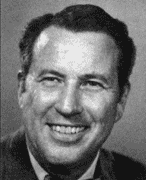
Wiles Hallock
|
The Big Ten, founded in 1895, had an aversion to bowl games for the first half of its existence. Extending the season through December interfered with exams and increased the commercialization of the sport, which presidents struggled to confine within the boundaries of academic priorities.
- The conference forbade its members from playing in bowl games until 1945.
- In that year, the Big Ten signed a contract to send its champion to the Rose Bowl to face the winner of the Pacific Coast Conference.
- The arrangement between the Rose Bowl, the Big Ten, and what is now called the Pac-10 continues to this day. Even though both conferences and the Rose Bowl are part of the BCS, the champions of the two leagues meet in Pasadena unless one or both of them make the BCS Championship Game.
Each year from 1945-1974, only one Big Ten and one Pacific Coast team went to a bowl game. That rule punished some of the best teams in the nation. The most egregious result occurred in 1973 when Michigan finished 10-0-1. However, the tie was with Ohio State, making the Wolverines and Buckeyes co-champions. The Big Ten ADs chose OSU to represent the conference in the Rose Bowl. #6 Michigan stayed home. That same season, #9 UCLA also went nowhere after losing to USC.
Big Ten Commissioner Wayne Duke and his Pac-8 counterpart, Wiles Hallock, lobbied their schools to open bowl participation to more conference members. They marshalled some powerful arguments.
-
The conferences were passing up a great deal of extra revenue provided by bowl games.
-
Recruiting was hampered because athletes wanted to go to colleges where they would have a better chance of playing in bowl games. Duke felt that recruiting difficulties were the big reason the Big Ten was dismissively called "the Big Two (Michigan and Ohio State) and the Little Eight." Why would an elite player want to go to, say, Indiana knowing that the Hoosiers had little chance of winning the conference and going to the Rose Bowl?
-
Playing in bowl games gave schools prime tv exposure.
-
Bowl game participants got to practice an extra 3-4 weeks.
-
Notre Dame, a school Big Ten members recruited against, had revoked its bowl ban (in effect since the 1925 Rose Bowl) during the 1969 season.
Both conferences agreed to end their post-season limitations starting in 1975. As usual, the conference champs, UCLA and Ohio State, met in the Rose Bowl. However, additional teams enjoyed the bowl experience.
With 6 to 8 more attractive teams available each year, the number of bowl games increased from 10 in 1974 to 15 in 1978. In the latter year, three Big Ten and four Pac-10 teams went bowling. Because of the Rose Bowl's huge payout ($5.2 million to the two teams in 1979), participation in additional bowls gave the two conferences half of all postseason dollars.
|
Reference: The 50 Year Seduction: How Television Manipulated College Football,
from the Birth of the Modern NCAA to the Creation of the BCS, Keith Dunnavant
|
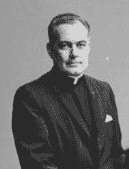
Rev. Theodore Hesburgh
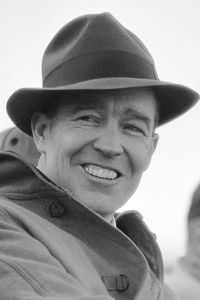
Frank Leahy
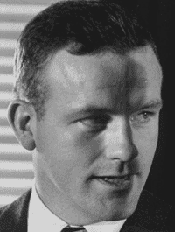
Terry Brennan
|
When Rev. Theodore Hesburgh, C.S.C., became the President of Notre Dame in 1952, he faced a huge dilemma.
- The school was undoubtedly the most famous private college in the nation. That should have pleased its new chief. However, what bothered him was why the South Bend institution had achieved its fame and popularity. Hesburgh hated the term "football factory" that, fairly or not, many people applied to the school. He had studied the football program during his three years as executive vice-president and wondered how it could have gotten so out of control. Football players were accepted into the university who could not meet the academic requirements.
- The priest of the Holy Cross Order, whose members had founded Notre Dame in rural Indiana in 1842, longed to change the perception of the all-male school into the "Harvard of the Midwest." In Hesburgh's mind, achieving his academic goals required reining in football. Yet that objective brought him into direct conflict with the man who ruled that program with an iron hand: Coach Frank Leahy.
Hesburgh possessed an important ally in carrying out his plans. His close friend and brother priest, Father Edmund Joyce, had assumed Ted's former post of executive vice-president and was also chair of the faculty board in charge of athletics. Joyce's philosophy was summarized in this statement.
Naturally, we would like to have a winning football team, but it is not so important as all that. I can understand the attention that the football team has received, because of the past, but you must remember that Notre Dame is a great academic institution and it has been for many years.
Together, the two men began their crusade to put football in its place. In so doing, they were simply continuing policies initiated by the previous president, Father John Cavanaugh, who had hired Leahy in 1941.
- In 1947, Cavanaugh cut football scholarships from 32 to 18 a year.
- Two years later, when Cavanaugh elevated Hesburgh to the vice-presidency, he ordered him to get control of Leahy, who seemed to be doing whatever he pleased, confident that his adulation by the alumni for fielding national champion teams allowed him run his own fiefdom independent of the university at large.
Leahy had refused to even talk to his new boss. When Hesburgh summoned Leahy to his office, the coach usually sent an assistant. The head coach's unpredictable behavior also disturbed Hesburgh.
- After some losses, Leahy had walked to a corner of the dressing room and cried.
- At halftime of the 1951 Michigan State game, he accused the players of throwing the game in order to win their bets.
- Leahy required players to attend illegal summer practices at a farm outside Cleveland where he worked them almost beyond their endurance.
- The only blemish on the 1953 record was a tie with Iowa. Notre Dame salvaged the tie by having players fake injuries to stop the clock at the end of each half when the team was out of timeouts.
During that same 1953 season, Leahy unwittingly gave Hesburgh and Joyce the opening they needed.
- Frank fainted in the locker room during the Georgia Tech game. The cause turned out to be acute pancreatitus, which was successfully treated, allowing him to return to the sideline in two weeks.
- The two priests began making a case that Leahy's fragile health raised doubts about his ability to coach.
- On January 31, 1954, Leahy resigned with two years remaining on his contract. The supposed reason was that his doctors has warned him that his health would suffer if the continued to coach. But in reality he quit because he felt he was no longer wanted - which, as far as his two bosses were concerned, was true.
Leahy's final record at ND was 87-11-9. While he fell short of Knute Rockne's 105 wins, Frank had one more undefeated season than Knute.
Hesburgh-Joyce replaced Leahy with 25-year-old Terry Brennan, a star RB under Leahy who had coached Mount Carmel High of Chicago for three years. This move ushered in the worst era of Notre Dame football.
- After going 17-3 in his first two years with the talent Leahy left, Brennan saw his 1956 squad, led by Heisman Trophy winner Paul Hornung, fall to 2-8, Notre Dame's first losing season since 1933. After rallying for 7-3 and 6-4 seasons the next two years, including snapping Oklahoma's 47-game winning streak in 1957, Brennan was fired.
- Joe Kuharich went 17-23 the next four years before Hugh Devore took over for one season (2-7 in 1963).
- Fighting Irish football finally turned around with the hiring of the first non-grad as coach in 1964: Ara Parseghian.
|
|
On
November 14, 1943, Sammy
Baugh of the Washington Redskins
made NFL history when he threw four TD passes and intercepted four Detroit
Lions passes in a 42-20 win in Washington.
- That season Baugh led the league in passing, interceptions, and punting.
He holds the record for highest punting average in a season (51.4 yards
in 1940).
- His career average of 45.1 yards per punt was also a record
until broken by Shane Lechler of Oakland (2002-05).
- A strong case can be made for Baugh as the
greatest all-around football player ever.
|
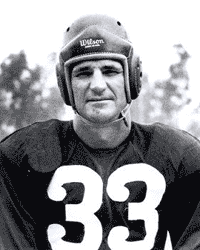 |
Bridgadier
General Robin
Olds died on June 14, 2007 at age 84. He was a highly-decorated
pilot from World War II as well as the Vietnam War. Olds
was inducted into the U.S. National Aviation Hall of Fame in 2001. What
has all this got to do with football? Well, Olds is the
only person to be enshrined in both the Aviation and the College Football
Halls of Fame.
- He was an All-American
tackle at West Point in 1942 in Earl
"Red" Blaik's first year as head coach.
- Robin was voted "Lineman of the Year" by Colliers magazine.
- Elected captain of the 1943 team, he left West Point early to serve in
World War II.
|
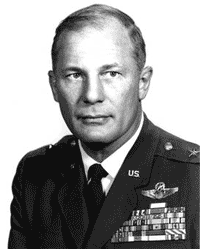 |
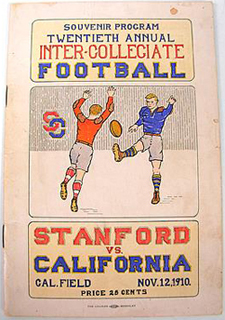
"Inter-collegiate Football" meant Inter-collegiate Rugby in 1910; note the shorts on the players in the illustration |
"The Big Game" - Rugby
In
1905, reform swept through college football in the East.
- Even President Theodore
Roosevelt got involved, calling a meeting of college representatives
to discuss brutality and the lack of sportsmanship on the gridiron.
- Eventually rules were changed to open up the game, including liberalization
of the forward pass as an alternative to the brute force flying wedge.
- Reforms included steps to require players to be bona fide students who
did not receive illegal inducements.
The
winds of change reached the West Coast, which had fewer schools. The
only heated rivalry in the area was California
– Stanford. The
annual Big Game (as it is still known today) entranced both campuses
for at least a week. The presidents of both schools were ready for change.
- They wanted to end the corruptive influence of eastern football. So
they decided to substitute rugby for American football.
(Soccer was also considered.)
- They hoped for fewer injuries, less disruption
of academic life, and a decrease on the commercialization of college
athletics.
- The Stanford
and Cal coaches spent
the spring of 1906 studying rugby in order to play a fall schedule.
- Following the lead of the West's two leading football schools, many
high schools and other colleges in the area followed suit.
For
ten years, rugby served as the fall game in California but without much
enthusiasm.
- In 1915, the student-controlled athletic association at
Berkeley broke the contract with Stanford and returned to American football.
- In 1916, Cal played its Big Game against Washington, which had never
dropped the sport.
- Following World War I, Stanford alumni and students successfully lobbied for the return of American
football.
Reference:
College
Football: History, Spectacle, Controversy, John Sayle Watterson |
What college team had the most future NFL Hall of Famers on
its roster? Was it one of the great Notre
Dame teams? Or USC?
Michigan? Alabama?
Nebraska? Wrong on all
counts, penalty breath. The team was the 1951 San Francisco
Dons with three Hall of Famers (out of nine drafted by the
NFL – five of whom played in the Pro Bowl).
Coached
by Joe
Kuharich, who later led Notre
Dame and the Philadelphia
Eagles, the Dons finished 9-0.
- Rebuffed
by Stanford and Cal,
the small Jesuit school played two games against San
Jose State and also defeated Camp Pendleton
Marines and San Diego Naval Training Center.
- The biggest victory was 32-26 over Fordham in New York City.
- SF's PR man, Pete Rozelle,
drove legendary sportswriter Grantland Rice to the
game so he could see Matson, who led the nation in
yards (1,566) and TDs (21) that season but made All-American as a DB
in the era of one-platoon football.
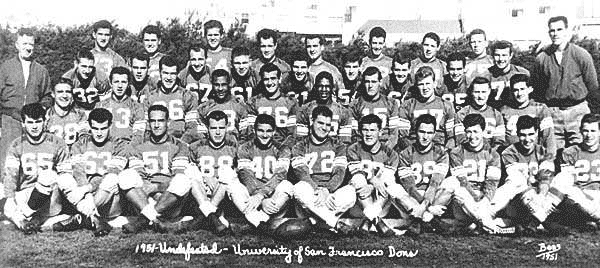
After
defeating Loyola 20-2
in Pasadena in the season finale, the team awaited a bowl bid. However,
there was a stated problem and an unstated problem in inviting the Dons
to a bowl, which were all in the South except for the Rose Bowl (which
was Big 10 vs. Pac 8).
- The stated problem was SF's weak
schedule.
- The unstated obstacle was that Matson and
DB Burl
Toler were black, and the team refused to play a bowl game
without them.
With
no bowl revenue to help erase the $70,000 athletic deficit, the university
board dropped football a month after the season ended. USF has never fielded a football team since. At least they went out in a blaze of glory.
|

Joe Kuharich
|
The last Philadelphia Eagles home game of the 1968 season on December 15 found the fans in a decidedly Scrooge-like mood. After losing their first eleven games, the Eagles had defeated the Lions and Saints the last two weeks. Still, they had clinched the worst record in team history. So, even though they were tied with the Minnesota Vikings 7-7 at halftime, many of the 54,530 fans in Franklin Field took out their frustration on whatever targets they could find.
- Fans, many wearing "Joe Must Go" buttons, bombarded fourth-year Eagles Coach Joe Kuharich with snowballs as he left the field at halftime.
- During the halftime show, many in the audience vented their ire on an unsuspecting target and, in so doing, cemented The City of Brother Love's reputation for having the toughest fans in America.
19-year old Frank Olivo had been wearing a Santa suit and fake white beard to the last Eagles home game for several years.
- During the first half, the Eagles' entertainment director learned that the man he hired to play Santa in the halftime show was stranded by the snowstorm that had hit the area.
- So the director roamed the stands looking for a substitute Santa and found Olivo.
The replacement Santa ran downfield as part of the halftime show as the Eagles' band played "Here Comes Santa Claus."
- The crowd booed strongly, and, as Olivo reached the end zone, some pelted him with snowballs.
- He wagged his finger at the crowd as if you to say, "Shame on you! You're not getting anything for Christmas."
The Vikings won the game 24-17 to clinch the NFL Central Division and make the Eagles' final record 2-12. Kuharich was fired and replaced by Jerry Williams.
The booing and bombarding of Santa might have gone unnoticed if Howard Cosell hadn't talked about it on his nationally-syndicated radio show the following Tuesday. As a result, Eagles fans ever since have had to live with the reputation of being so mean that they even booed Santa Claus.
|
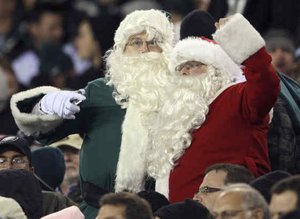 Frank Olivo (in red suit) and friend at last Eagles home game of 2009
Frank Olivo (in red suit) and friend at last Eagles home game of 2009 |
Postscript: Fast-forward to December 27, 2009 and the last Eagle home game at Lincoln Financial Field, which replaced Veterans Stadium, which replaced Franklin Field as the Eagles' home. (Franklin Field continues as the stadium of U. of Pennsylvania.)
- Frank Olivo attended in a Santa suit for the first time in decades.
- When people in his section found out that he was the guy they had heard about all their lives, the Santa who got booed, they wanted him to sign autographs and take a picture with him.
Olivo told the Philadelphia Daily News: "I could never boo any player. I know what it feels like to get booed by 60,000 people and, let me tell you, it hurts. I understand it because I am a fan first, but, yeah, I am scarred from that moment." Frank has never wanted the attention that the incident had brought him. "Put it to rest. It happened 41 years ago. Time to move on."
|
|
One of the hallowed stories of SEC lore concerns Hargrove Vandegraaff of Alabama, who refused to leave the 1913 game against Tennessee even though his ear was badly cut.
- Volunteer lineman S. D. "Bull" Bayer recalled many years later:
His ear got a nasty cut at its top. It was dangling from his head a bit, bleeding a lot. He got his ear caught in the leg of my pants a play or two later, and he got so mad about it that he jumped to his feet, grabbed his ear and tried to yank it from his head. Boy, he was a tough something. He wanted to throw away his ear so he could keep playing. In all my days of football, I never saw anything like that again.
- Hargrove's teammates stopped him from pulling off his ear, and the managers bandaged it so that he could continue.
The November 13 game lasted into the Tuscaloosa twilight.
- Spectators with automobiles were asked to park them at the edge of the field and turn on the headlines so that the contest could be completed.
-
Alabama prevailed 6-0, their second straight shutout of the Vols.
In 1915, Hargrove's younger brother, W. T. "Bully" Van de Graaff, became Alabama's first All-American. (Some accounts of the story have Bully as the one who tried to pull off his own ear.) A third brother, Adrian, Jr., also played for the Crimson Tide.
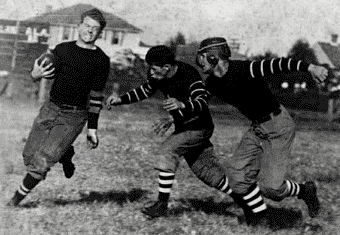 Bully Van De Graaff running the ball Bully Van De Graaff running the ball
The boys inherited their love of football from their father. Adrian Van de Graaff, Sr., had been a sub on Yale's first 11-man football team in 1880.
The youngest Van de Graaff boy, Robert, became the most famous of the brothers, but not from football.
- Robert went out for football at Tuscaloosa High, but a severe injury curtailed his career in 1917. He suffered a broken femur and injured his back.
- The youngest son spent the rest of his senior year recuperating at home, which gave him plenty of time to read. He particularly enjoyed books about engines.
- Robert graduated from Alabama in 1923 with a master's degree in mechanical engineering. He earned a Rhodes Scholarship to study at Oxford, where one of the world's greatest scientists, Ernest Rutherford, was experimenting with atomic particles.
- After obtaining a Ph.D. in physics, Robert joined the Palmer Physics Laboratory at Princeton University. In the fall of 1929, he constructed the first working model of what came to be known as the Van de Graaff Generator. This invention helped unlock the secrets of the atom and contributed greatly to the explosion of scientific knowledge in the 20th century.
|

Bully Van De Graaff
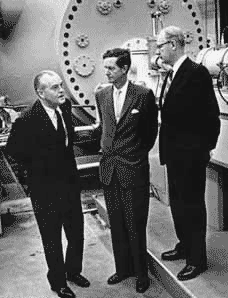
Robert Van de Graaff (far left) in front of his generator
|
|
He Did It Many Times in Madden
|
One of the best plays of the 2009 NFL season occurred on the very first Sunday in the game between the Denver Broncos and Cincinnati Bengals at Paul Brown Stadium.
- With 28 seconds remaining, the Broncos trailed 12-7. On second down from their own 13, Denver QB Kyle Orton threw the ball downfield. A Bengal defender knocked the ball away from the receiver only to see it deflect into the hands of WR Brandon Stokley who was behind every defender.
- Stokley raced down the field to the EZ, but as he approached the goal line with no defender close to him, he cut right 90 degrees and ran along the 1 yd line parallel to the goal.
- Not until a Bengal approached did Brandon finally step into the end zone to score the go-ahead TD and finally stop the clock. The delay ate up 6 more seconds, leaving Cincy with only 11 seconds to mount a comeback.
Watch a video of the play.
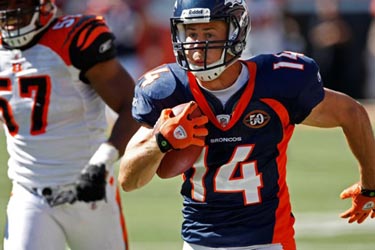 
L: Stokley racing toward the EZ vs. Bengals; R: Stokley running at 1 to milk the clock
|
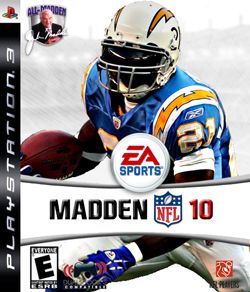
|
Did Stokley decide to delay crossing the goal line on the spur of the moment? Had he been coached to do that? Or had he done it in an earlier game?
- The answer is that he had done it in previous games many times. Only they weren't real games.
- When asked a few weeks later, "Is that something out of a videogame?" Stokley replied, "It definitely is. I think everybody who's played those games has do that."
- When asked how often he had run around the field to shave precious seconds off the clock in Madden NFL, Stokley answered, "Probably hundreds of times."
Current college and pro players have played more football than their predecessors.
- How can this be? you ask. The NCAA limits practice time, and NFL coaches have decreased full-contact practices to limit the wear and tear on their players.
- "But videogames, especially the ubiquitous Madden NFL, now allow athletes of all ages to extend their training beyond their bodies." The hundreds or even thousands of hours that athletes in many sports put into videogames give them more game experience and awareness than players from earlier eras could enjoy.
QBs have especially benefitted from "training on a very sophisticated, off-the-shelf simulator – a cross between a football tutorial and a real-time documentary ..."
- Ben Roethlisberger, Matt Ryan, and Joe Flacco are three recent QBs who started in their rookie season and did fine.
- High school and college coaches are starting to program their offenses into Madden so that their QBs, receivers, and O linemen can practice their assignments and learn to read defenses and make adjustments in real time. Some players scout their opponents via Madden and other game simulations.
- A player on the champion team of the Pop Warner Super Bowl in 2006 had programmed 30 offensive plays into Madden so that he and his teammates could learn their assignments. "It was easier than homework," the 11-year-old said.
- Marshall Faulk, All-Pro RB for the St. Louis Rams, estimates that 10-20% of players played videogames when he entered the league in '94. Stokley, when asked how many NFL players enjoy Madden today, said "Everybody."
Studies have shown that playing fast-paced videogames can help gamers "achieve faster reaction time, improved hand-eye coordination, and greatly increased ability to process multiple stimuli."
|
Reference: "Game Changer: How videogames trained a generation of pro athletes to play a
whole different kind of football," Chris Suellentrop, Wired, Feb 2010
|
|
CONTENTS
Stop him! Stop him!
Big 10 and Pac-8 Cave in
Fr. Hesburgh's Dilemma
Sammy's Big Day
Double Hall-of-Famer
"The Big Game" - Rugby
No Bowl for Dons
They Booed Santa
I Don't Need This Ear!
He Did It Many Times in Madden
Football
Stories –I
Football
Stories – III
Football Stories – IV
Football
Stories – V
Football
Stories – VI
Football
Stories – VII
Football
Stories – VIII
Football
Stories – IX
Football
Stories – X
Football Magazine
Golden Rankings Home
Top of Page |




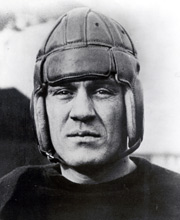
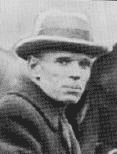







 Bully Van De Graaff running the ball
Bully Van De Graaff running the ball


